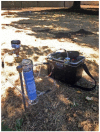High School Students as Citizen Scientists to Decrease Radon Exposure
- PMID: 33302585
- PMCID: PMC7763282
- DOI: 10.3390/ijerph17249178
High School Students as Citizen Scientists to Decrease Radon Exposure
Abstract
Residents in rural Kentucky (KY) and suburban Ohio (OH) expressed concerns about radon exposure and lung cancer. Although 85% of lung cancer cases are caused by tobacco smoke, radon exposure accounts for 10-15% of lung cancer cases. Academic and community members from the University of KY and the University of Cincinnati developed and pilot-tested a family-centered, youth-engaged home radon testing toolkit. The radon toolkit included radon information, and how to test, interpret, and report back findings. We educated youth as citizen scientists and their teachers in human subjects protection and home radon testing using the toolkit in the classroom. Youth citizen scientists explained the study to their parents and obtained informed consent. One hundred students were trained in human subjects protection, 27 had parental permission to be citizen scientists, and 18 homeowners completed surveys. Radon values ranged from < 14.8 Bq/m3 to 277.5 Bq/m3. Youth were interested and engaged in citizen science and this family-centered, school-based project provided a unique opportunity to further the healthy housing and quality education components of the Sustainable Development Goals for 2030. Further research is needed to test the impact of student-led, family-centered citizen science projects in environmental health as part of school curricula.
Keywords: cancer prevention; citizen science; lung cancer; radon; youth-engaged.
Conflict of interest statement
The authors declare no conflict of interest.
Similar articles
-
Citizen Science Approach to Home Radon Testing, Environmental Health Literacy and Efficacy.Citiz Sci. 2022;7(1):26. doi: 10.5334/cstp.472. Epub 2022 Jun 2. Citiz Sci. 2022. PMID: 36845873 Free PMC article.
-
Citizen Science: A New Approach to Smoke-Free Policy Advocacy.Health Promot Pract. 2020 Jan;21(1_suppl):82S-88S. doi: 10.1177/1524839919883586. Health Promot Pract. 2020. PMID: 31908201
-
Associations Between School Characteristics and Classroom Radon Concentrations in Utah's Public Schools: A Project Completed by University Environmental Health Students.Int J Environ Res Public Health. 2020 Aug 12;17(16):5839. doi: 10.3390/ijerph17165839. Int J Environ Res Public Health. 2020. PMID: 32806724 Free PMC article.
-
Evaluation of citizen science contributions to radon research.J Environ Radioact. 2021 Oct;237:106685. doi: 10.1016/j.jenvrad.2021.106685. Epub 2021 Jul 12. J Environ Radioact. 2021. PMID: 34265518
-
An overview of the North American residential radon and lung cancer case-control studies.J Toxicol Environ Health A. 2006 Apr;69(7):599-631. doi: 10.1080/15287390500260960. J Toxicol Environ Health A. 2006. PMID: 16608829 Review.
Cited by
-
The Role of Citizen Science in Promoting Health Equity.Annu Rev Public Health. 2022 Apr 5;43:215-234. doi: 10.1146/annurev-publhealth-090419-102856. Epub 2021 Nov 1. Annu Rev Public Health. 2022. PMID: 34724389 Free PMC article. Review.
-
Identifying Factors Influencing Attention in Adolescents with a Co-Created Questionnaire: A Citizen Science Approach with Secondary Students in Barcelona, Spain.Int J Environ Res Public Health. 2021 Aug 3;18(15):8221. doi: 10.3390/ijerph18158221. Int J Environ Res Public Health. 2021. PMID: 34360520 Free PMC article.
-
A Qualitative Study of the Ethics of Community Scientists' Role in Environmental Health Research from the Perspective of Community Scientists and Institutional Review Board Staff.Environ Health Perspect. 2025 May;133(5):57019. doi: 10.1289/EHP15824. Epub 2025 May 23. Environ Health Perspect. 2025. PMID: 40239124 Free PMC article.
-
Crowdsourcing to support training for public health: A scoping review.PLOS Glob Public Health. 2023 Jul 26;3(7):e0002202. doi: 10.1371/journal.pgph.0002202. eCollection 2023. PLOS Glob Public Health. 2023. PMID: 37494311 Free PMC article.
-
Authentic Youth Engagement in Environmental Health Research and Advocacy.Int J Environ Res Public Health. 2021 Feb 23;18(4):2154. doi: 10.3390/ijerph18042154. Int J Environ Res Public Health. 2021. PMID: 33672107 Free PMC article.
References
-
- Overfield B.L., Andrews W.M., Jr., Robertson H., Rayens M.K., Hahn E.J. Radon research collaboration between the Kentucky Geological Survey and the University of Kentucky College of Nursing: An innovative partnership. Geol. Soc. Am. Spec. Pap. 2016;520:267–271.
-
- US Department of Health and Human Services . Surgeon General Releases National Health Advisory on Radon. US Department of Health and Human Services; Washington, DC, USA: 2005.
Publication types
MeSH terms
Substances
Grants and funding
LinkOut - more resources
Full Text Sources
Medical


